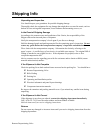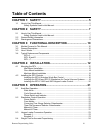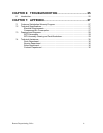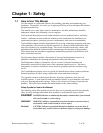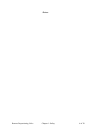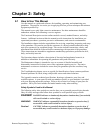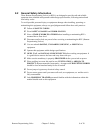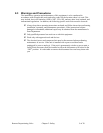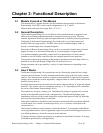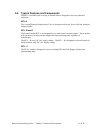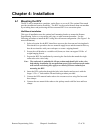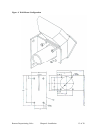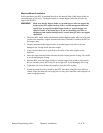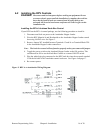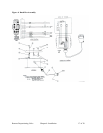
Remote Proportioning Valve Chapter 3: Functional Description 10 of 30
Chapter 3: Functional Description
3-1 Models Covered in This Manual
This manual offers a general reference for the installation and operation of the Remote
Proportioning Valve (RPV) with control configurations A, B, C, and D.
Material inlets and outlet sizes range from 1.5” to 2.5”.
3-2 General Description
The Remote Proportioning Valve is an efficient and economical means to proportion two
different free-flowing granulated materials in a material conveying system. The most
common application is mixing virgin and regrind materials in a plastic processing operation.
The design of the Remote Proportioning Valve lends itself to use in both central and
machine-side conveying systems. The RPV also can turn a standard hopper loader or
anyone’s vacuum hopper into a proportioning unit.
Mounting of a Remote Proportioning Valve can be at a convenient location away from the
hopper or loader or on the material inlet tube of a vacuum hopper or hopper loader.
Two urethane plungers operated by compressed air are positioned in a central vacuum
chamber to provide airflow control between two separate material conveying lines.
The operator controls the positioning of the plungers and dictates the percentage of the two
materials to be delivered through a single hose to a material receiver.
Plunger operation can be governed by a variety of control alternatives, depending on the
installation.
3-3 How it Works
The Remote Proportioning Valve proportions two free-flowing dry materials into a single
vacuum conveyed stream. It can be mounted some distance from or directly on the vacuum
receiver. Two material inlets lead into a central vacuum manifold. Compressed air operated
plunger valves switch the vacuum supplied by a hopper loader or central system between two
material pick-up devices.
Switching between the inlets at timed intervals creates a known mixture of virgin and regrind
materials. The mixture can have a minimum accuracy of 5%, depending on how controlled
the set-up of the Remote Proportioning Valve is.
The controls are set up on a timing cycle. The Material A plunger is opened to the vacuum
stream for an adjustable period of time, and then closes. The Material B plunger opens
immediately and conveys the second material for an adjustable period of time. By adjusting
these intervals, the proportioning is controlled.
Under ideal conditions with identical total resistance in both material hoses and the Material
A and B timers set at 10 and 5 seconds respectively, a 2-to-1 mixture is delivered to the
vacuum receiver.
Under actual conditions, total resistances will not be identical. Two materials with different
conveying characteristics, such as regrind and virgin, conveyed from differing pickup devices
over differing distances, are not be conveyed at the same rate.
To ensure a mixture of known proportions, a weight test as described in Section 5-4 on page
24 should be performed for each application.



